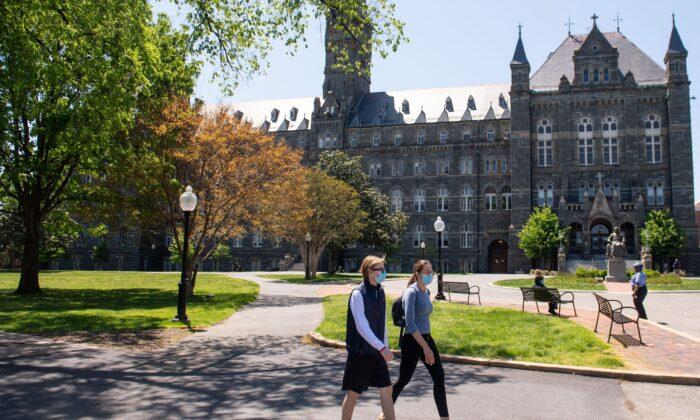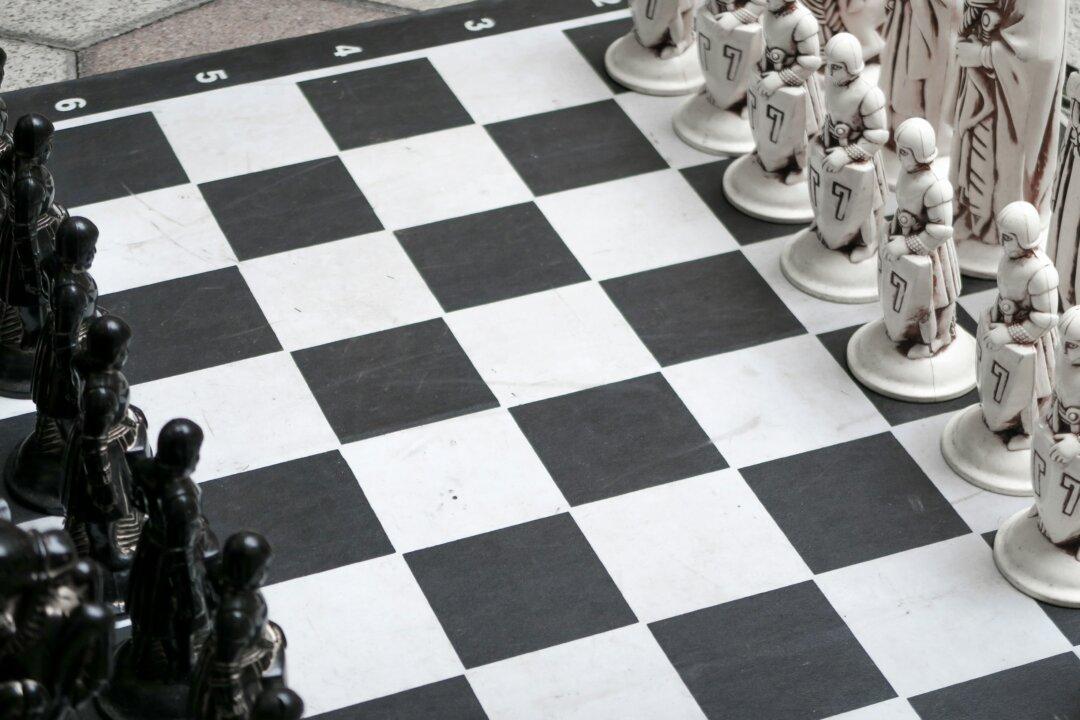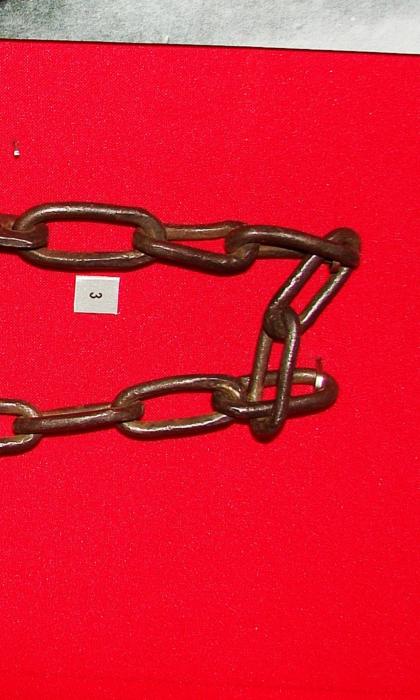In the annals of racial reckoning, Georgetown University’s public atonement for its historical links to slavery has attracted special attention and generous praise.
Since the student newspaper jolted the campus with accounts of Jesuit priests engineering the sale of 272 enslaved people in 1838 to stave off bankruptcy for the college, Georgetown has honored campus buildings after an enslaved black laborer and a black Catholic educator, and pledged funding for health clinics and local schools. The prestigious institution now offers preferred admissions status in perpetuity to descendants of people the Maryland Jesuits once owned.
“Take a bow, Georgetown University,” a Dallas Morning News columnist gushed in 2016. “When one of America’s most prominent universities takes a step—no matter how small—to atone for its role in slavery, history pivots.”
But what began with a grandiosity of purpose as a model for racial reconciliation—including a Catholic mass of contrition in Washington in 2017 that featured official apologies for having “greatly sinned”—has veered off script, confounding the moral clarity of the present that seeks to correct for moral blindness of the past.
Georgetown officials assumed that the fate of the 272 sold slaves could never be known, rendering their descendants non-persons. Turns out, the Maryland Jesuits were meticulous record keepers. Historians and genealogists have scoured their remarkably intact archival records to find that that Jesuit slavery was more extensive than many had assumed.
They estimate that as many as 1,650 people were enslaved—or, just as important: leased—over more than a century and a half at Georgetown College and the six Jesuit plantations in Maryland that financed the school’s operations.
These slaves and their progeny, in turn, begat an estimated 12,500 descendants who are believed to be alive today. About half of the descendants have been found through genealogical research, and more could be located as additional slave identities are reconstructed. Many, however, are still in the dark because genealogical researchers lack the resources for personally notifying every person added to their growing roster.
The expanding universe of descendants has complicated the racial reckoning for Georgetown, which is facing mounting inquiries and claims from descendants who are just learning of their connection to the Jesuits. While most news accounts have focused on the 272 enslaved people who were sold, little attention has been paid to the rising chorus of critics who say the school must acknowledge its much wider debt.
“Why is everyone so focused on the sale? Wasn’t the ownership of slaves the real problem here?” said Richard Cellini, a Georgetown law school alumnus who created a nonprofit organization to conduct genealogical research for descendant families. “There’s still more than a thousand Jesuit slaves out there that almost no one talks about, nobody knows about, nobody’s provided any resources for.”
Georgetown’s reckoning with its past is a microcosm of the profound and difficult questions—both moral and financial—inherent in the discussion of reconciliation and reparations. Even as the university has moved to open its past to unprecedented scrutiny, it has faced increasing criticism and demands.
The story began in 2014 when Georgetown’s student newspaper began reporting the 1838 sale of 272 enslaved people. Students protested to pressure university leaders to strip two campus buildings of the names of the Jesuit slavers who engineered the sale, realizing more than $3 million in today’s dollars. The university community was moved to make amends after reading news stories in The New York Times and other outlets that described contemporary accounts of women weeping, slaves fleeing into nearby woods, and families torn asunder, as the terrified slaves were packed into awaiting oceangoing brigs under the supervision of a local sheriff and shipped more than 1,000 miles to sugar and cotton plantations in Louisiana.
In response to intensifying interest in this history, university president John DeGioia in 2015 commissioned a Working Group on Slavery, Memory, and Reconciliation to prepare a report and recommendations on a comprehensive institutional response.
Georgetown opened its archives to the broader public, posting letters, bills of sale, financial statements, runaway notices, sacramental records, and other documents online that help historians, genealogists, and family members connect enslaved ancestors to living descendants. Notably, the Jesuit university and the religious order did not conduct genealogical research to find descendants, leaving that work to individual families.
Sensing a massive historical wrong, Cellini hired two genealogists and in 2015 created the Georgetown Memory Project, which characterizes its efforts as “one of the largest group-genealogy searches in US history.”
Detailed records kept by the Jesuits have revealed that the Maryland Province Jesuits owned at least 1,150 slaves over more than 150 years, according to research by Sharon Leon, a scholar of U.S. Catholicism at Michigan State University who specializes in digital methods. What’s more, historians and researchers say the religious order benefited from as many as 500 other slaves whose financial ties to the Maryland Jesuits have been overlooked. These enslaved people cooked and cleaned at Georgetown College, or plowed and harvested the six Jesuit plantations in Southern Maryland, but don’t show up in the records as Jesuit property because they were owned by tenant farmers, local residents, and students’ parents.
Complicating the matter for Georgetown and the Jesuits is a vocal group of descendants, said by their attorney to number in the hundreds, who have sparred with other descendants over the proper way to honor their ancestors.
This group is less interested in what they perceive as symbolic gestures—like renaming campus buildings and offering preferential admissions to descendants—than in receiving scholarships and cash payments as recompense for the unpaid labor of their ancestors.
And they want help with genealogical research, which can be time-consuming and expensive.
One of these dissenters is Karran Harper Royal, a New Orleans resident who learned in 2016 that her husband Kenneth descends from Isaac Hawkins, an enslaved person sold in 1838 and whose lineage has produced at least 2,600 descendants, both deceased and living. Harper Royal, 59, is an outspoken descendant activist and was one of the featured speakers at Georgetown’s 2017 ceremony and liturgical service.
“Those bread crumbs they’re throwing out there, that’s PR management, it’s not real amends,” said Harper Royal, who works as an advocate for disabled children. “If they’re going to let people in based on legacy, the least they could do is help people verify their lineage.”
These unanticipated developments have placed Georgetown and the Jesuits in a peculiar predicament.
“For a university like Georgetown, or even for the Jesuits, some uncertainty comes from not known how large the community is that you’re dealing with,” said Georgetown history professor Adam Rothman, who oversees the Georgetown Slavery Archive, the online repository of archival materials pertaining to slavery, the Maryland Jesuits and Georgetown University.
“But more it’s just the novelty of it,” Rothman said. “Universities have not had to confront a descendant community demanding reparations before. So they don’t know how to respond to it. Is this a legal question? Is it a moral question? Is it a public relations issue? How do we navigate this terrain?”
There is no single model in this country for racial reconciliation, whether offering financial benefits to African Americans or other forms of recognition.
In the absence of a national program, individual organizations, businesses and municipal governments, including Evanston, Ill., and Asheville, N.C., have vowed to pay what they call reparations to black people for the municipalities’ role in historic discrimination.
Universities are in the forefront of the movement to come clean on their record of racial exploitation and exclusion, with nearly 100 institutions active in Universities Studying Slavery, a consortium formed in 2016 that meets twice a year and includes Brown, Columbia, Emory, Harvard, Yale as well as universities in Ireland, England, Canada, and Colombia. Universities typically didn’t own large numbers of slaves, but they benefitted from wealthy benefactors who were enriched by investing the slave trade or in Caribbean slave plantations, or from the labor of enslaved people owned by faculty, leadership, and even students.
Thus a genealogist hired by William & Mary University, researching for more than a year, told RealClearInvestigations (RCI) he has yet to identify a living descendant from 200-plus slaves who are known to have worked on the campus in Williamsburg, Va., between 1693 and 1862. The enslaved might be recorded as “negro boy” or “male” or by a first name only.
And a genealogist hired by the University of Virginia, who is in her third year of research, said she has successfully identified 60-plus living descendants, and expects to identify others. But out of an estimated 4,000 slaves who labored at UVA in various capacities during the years 1817 and 1865, many were recorded by a first name only or not identified at all, and it will be more challenging if not impossible to find their descendants.
Georgetown and the Jesuits, with an increasing community of descendants, face considerations of a different nature than most organizations are likely to encounter.
“It’s morally terrifying to imagine that they survived,” said Cellini, 59, who for the past year has been a faculty fellow at Harvard University. “They weren’t looking for this. It’s a source of great shame. It worries them from a financial standpoint.”
Such quandaries must have seemed remote to Jesuit leaders and Georgetown officials when they pointed their moral compass toward a racial reckoning in 2015.
When Georgetown president DeGioia in 2015 commissioned a Working Group on Slavery, Memory, and Reconciliation to prepare a report and recommendations, no one on the 15-member committee was aware of living descendants of Jesuit-owned slaves, said Rothman, a member of the Working Group. According to one news report, DeGioia said it would have never occurred to him the descendants wanted to engage with Georgetown.
The fate of the descendants piqued the curiosity of Cellini, who emailed the Working Group for information about descendants and the possibility of reparations.
Georgetown English professor John Glavin responded in mid-November, saying that the question of descendants was a non-starter: “The problem with making some sort of reparation to the descendants of the slaves sold south is that, as far as we can tell, all of them quickly succumbed to fever in the malodorous swamp world of Louisiana.” Glavin added: “The best available evidence suggests that, used to the more temperate climate of Maryland, and the kind-ish oversight of the somewhat feckless Jesuits, almost all of them immediately succumbed to the hostile climate and the harsh labor conditions into which they were so suddenly and cruelly submitted.”
Cellini typed a query in the Google search engine, and quickly found information posted by a descendant who had been working with a Baton Rouge genealogist. This surprise discovery prompted Cellini to hire that genealogist, as well as another genealogist in Maryland, launching the Georgetown Memory Project.
Cellini said he has received no financial help from the Jesuits or the university. He described his motivation as anchored in the Jesuit ethic of serving others, noting: “I’m a moderate Republican; I’m not a social justice snowflake.”
Meanwhile, Georgetown ceremoniously removed the names of the two Jesuit priests from campus buildings, and christened the structures after Isaac Hawkins, the first of 272 names listed on the 1838 manifest for the mass sale, and named another building after Anne Marie Becraft, a free black Catholic educator who founded the first school for black girls in Georgetown.
Georgetown also committed to raise $400,000 a year from philanthropic donations to support projects benefiting descendant communities, and offered preferential admissions to descendants of the Jesuit-owned slaves. To date 16 descendants have been admitted under the special preference, including Mélisande Short-Colomb, a New Orleans chef who was 63 years old when she enrolled at Georgetown in the fall of 2017.
Some universities, however, are expressly committing to help find living descendants. In April, Harvard University pledged $100 million for the creation of a Legacy of Slavery Fund that will help search for descendants of the 70-plus black and Native American people enslaved by Harvard faculty, presidents, major donors, and other figures in the 17th and 18th centuries.
Georgetown spokesman Jason Shevrin, in an email to RCI, underscored the university’s “ongoing commitment to reconciliation and collaboration with Descendants.”
“Georgetown is committed to supporting community-based projects in partnership with Descendant communities,” Shevrin wrote. “This work is grounded in our academic mission of education, research, and service.”
But Shevrin did not respond to questions about whether the university plans to underwrite genealogical research. It’s also unclear whether the hundreds of slaves not owned by the Jesuits, but included in the total headcount by historians and the Georgetown Memory Project, will be eligible for preferential admissions or other forms of recognition at Georgetown; however, recognizing such slaves is common practice by other universities, including William & Mary, University of Virginia, and Harvard.
By the time that Georgetown announced the special admissions program in September 2016, the Georgetown Memory Project had identified 1,250 living descendants, and it was becoming impossible to ignore their growing ranks.
When GU President DeGioia announced that descendants would get legacy admissions preference and that the university would establish a center to study slavery and commission a memorial to slaves, praise poured in from all quarters for Georgetown’s visionary leadership.
“This is the biggest news in reparations in years,” Alfred Brophy, then a law professor at the University of North Carolina-Chapel Hill who studies the history of slavery and universities, was quoted in The Los Angeles Times.
‘‘It goes farther than just about any institution,’‘ Massachusetts Institute of Technology slavery historian and author Craig Wilder told The New York Times in 2016. ’‘I think it’s to Georgetown’s credit. It’s taking steps that a lot of universities have been reluctant to take.’’
Wilder is the author of the 2013 book “Ebony and Ivy: Race, Slavery, and the Troubled History of America’s Universities.” Brophy is a co-editor of the 2019 study, “Slavery and the University: Histories and Legacies.”
That same year, Harper Royal became involved in founding a new advocacy group, the GU272 Descendants Association, and published a piece in the Washington Post arguing that Georgetown wasn’t doing enough. She said the university should offer scholarships to the descendants, since the labor of the Jesuit-owned slaves made it possible for Georgetown College to admit students without charging tuition for the first half-century of its operations.
A year later, their frustration mounting, the GU272 Descendants Association sent a confidential plea to Rome, addressed to the Superior General of the Society of Jesus. Saying they have been ignored, the descendants requested the Society of Jesus to investigate the physical, social, educational, and economic harms that resulted from the 1838 sale, “continuing down to the present day,” and to research how much the descendants are owed.
They urged the Jesuit leader “to heal a great hurt, right a great wrong, and end a great and growing scandal in the Church.” The four signatories included Cellini and Harper Royal, all identified as lead organizers of the GU272 Descendants Association.
Subsequently the organization fractured.
The other two lead organizers, Cheryllyn Branche and Joseph Stewart, as well as another descendant, Earl Williams Sr., signed a memorandum of understanding with the Society of Jesus in September 2019, to work toward creating a $1 billion national organization to be called the Descendants Truth and Reconciliation Foundation, which would designate a quarter of its philanthropic outlays to funding descendants’ education expenses. Georgetown contributed $1 million to the planning the technical work required to establish the foundation.
The deal expressly took reparations off the table, with the Jesuits later stating that the descendants “chose not to seek individual cash settlements but rather to seek a substantial and sustainable investment forward in uplifting the wellbeing of Descendants for many generations to come.”
According to the foundation’s web site, it is structured to sustain financial and intellectual support of descendants’ educational attainment for the next hundred years. The Foundation will provide financial support to meet emergency needs of poor, ill, and elderly descendants.
Harper Royal, who was executive director of the GU272 Descendants Association, said she had no idea about the deal signed with the Jesuits, and she strongly disputes the language in the contract stating that the association represented the interests of the majority of descendants.
But the $1 billion goal remains a distant reality. The Jesuits committed $15 million and pledged to contribute a total of $100 million, from donations. The remaining $900 million would have come from other universities and institutions that are encouraged to join the effort. A spokesman for the new foundation said it’s in the early stages of being capitalized and declined to provide details on whether any other universities have signed on.
In April 2021, Harper Royal and four other descendants who were current or former members of the board of directors of the GU272 Descendants Association, including Cellini, issued a statement disavowing the GU272 group. They said the deal with the Jesuits was never reviewed by the GU272 board and that the broader descendant community was kept out of the loop.
But that’s not to say that their demand for reparations is universally popular.
Reparations expert William Darity, a Duke University professor of economics, public policy, and African and African American studies, does not blame universities or other entities for refusing to pay cash reparations to descendants. Darity has said it would be misguided for a stand-alone organization to cut checks, because the ultimate responsibility to do so falls on the federal government, and piecemeal efforts can only undermine achieving a national program.
Darity, author of the 2020 book, “From Here to Equality: Reparations for Black Americans in the Twenty-First Century,” said black people are entitled to about $350,000 per person in a $14 trillion program to erase the nation’s racial wealth disparity between black and white people.
“My position is: Take nothing if you’re not going to get what you deserve,” Darity told RCI.






